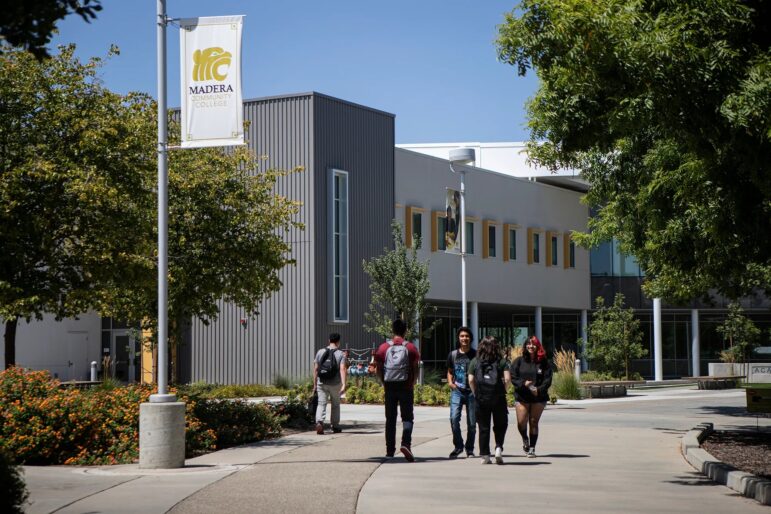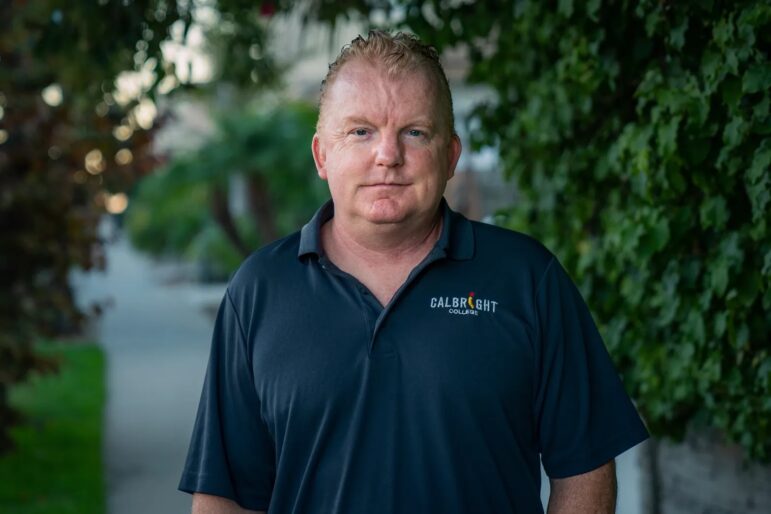A revolution is in the making at California’s community colleges: No more grades, no more sitting through lectures or seminars, no more deadlines. In a pilot program taking shape across eight of the state’s community colleges, the only requirement for some associate degrees will be “competency.”
Students who can prove that they have the relevant skills can earn that degree.
In theory, this model, known as “competency-based education,” could provide students with more flexibility and the potential to attain degrees faster in key job sectors. The pilot is geared toward working adults, many of whom left community colleges at record rates during the COVID-19 pandemic.
As the state’s population of K-12 students continues to shrink, leaving colleges with fewer students right out of high school, the pilot aims to attract adults who are already in the workforce by “valuing their lived and work experience,” said Madera Community College President Ángel Reyna.
If successful, these community colleges will set themselves apart from every other two-year institution in the country. The pilot, which launched in 2021, provides eight California community colleges with up to $515,000 over the course of four years to each design a single associate degree program using this new model.
The goal is for students to be able to enroll at some point in the 2024-25 academic year, said Aisha Lowe, an executive vice chancellor at the California Community College Chancellor’s Office. In practice, colleges must overcome bureaucratic and logistical hurdles to make the new system work. At least one community college says it is struggling to hit the state’s deadline.
The challenge is to create something that works “but isn’t so different that colleges can still wrap their heads around it and engage,” Lowe said. “It’s definitely unprecedented.”

The new model restructures the requirements of a degree to reflect what students have learned, rather than the amount of time they spend in class.
Currently, all college degrees require a certain number of hours spent in a classroom, either in-person or virtually. An associate degree, which California’s community colleges offer, requires roughly 3,000 hours spent in a classroom or on homework in a traditional academic year. That’s why some refer to it as a “two-year degree.”
Teachers get paid in part based on the number of hours they teach. Because of the high number of part-time students, the state funds colleges and universities based largely on the number of hours that a student spends in class, not the number of students themselves.
In this current system, students may be required to sit through classes to get college credit even if they can demonstrate they already have some of the requisite skills. Students who may have less time for school because of work or family obligations lose out too, said Charla Long, the president of the Competency-Based Education Network, a consultant for California’s pilot program.
“We’ve created an inequitable system because it’s so time bound,” she said.
In the new system, students seeking an associate degree in early childhood education at Shasta College in Redding will take 60 different exams, each one testing a specific skill, said Buffy Tanner, the college’s director of innovation and special projects. Students in the program will have materials to teach themselves, teachers will be available to answer questions and counselors will be able to provide wraparound support.
Currently, a student is required to take 20 semester-long classes for that same degree. Students in the new program will be able to take an exam up to three times and can move as quickly or as slowly as they want, Tanner said. In-state students in the new program who do not qualify for financial aid will pay the same total tuition, just shy of $2,800 for an associate degree, not including the cost of books, classroom supplies, or other miscellaneous fees. Shasta College, like the other colleges in the pilot, is still trying to figure out how much to pay faculty in the new system.
Not every student can succeed in this self-paced format. Tanner said the plan is to vet students for the program through questions about their lives and study habits: “Do you need external deadlines? What kind of self-discipline do you have?”
“We have to make sure students fully understand what they’re getting into,” she said.
Such alternative education systems have existed for decades. Since the 1970s, some colleges and universities have experimented with new models of teaching and learning that offer more flexibility and try to evaluate students based on what they know, not on how much time they spent in class, Long said.
In 1997, a group of 19 governors from Western states agreed to develop a private, nonprofit institution, known as Western Governors University, to provide “competency-based” education. With roughly 150,000 students today, it’s the largest higher education institution in the country. Though headquartered in Utah, the university is entirely online and boasts students from all 50 states.
Other large for-profit and non-profit university systems have experimented with the same model, including Capella University, an online college, and Southern New Hampshire University. California followed. In 2018, at the behest of former Gov. Jerry Brown, the state created a new community college, known as Calbright, which is free, entirely online, and exclusively “competency-based.”
“This is radically different, and an incredibly powerful way to support our students,” Calbright’s blog says about its model.
A 2020 survey of nearly 500 colleges and universities across the country found that 13% were already offering at least one degree or certificate through competency-based education and roughly half of those surveyed were in the process of adopting one, though the report noted that there’s “considerable variation” about how they define the model.
For Calbright student Jeremy Cox, the appeal was less about the instructional method and more about the convenience of online education. He started taking online classes in 2016 through for-profit companies such as Udemy and Coursera.
“To be able to just pull out a phone and bust out a couple of lessons from Udemy or Coursera, that’s very helpful,” he said.
One day while at a park near Long Beach with his children, Cox ran into a woman who told him about Calbright College. While Udemy and Coursera do not focus on a particular instructional method, Cox said his experience at Calbright College has been pretty similar, with two key differences. Unlike Udemy or Coursera, he said, Calbright provides teachers who are more available and respond quickly to questions via Slack, a messaging app. The other difference is social interaction. He has become involved in building community among his classmates and serves as the college’s first student body president.

Calbright has had consistent enrollment growth each academic year since it began, despite a scathing report from the state auditor’s office. State legislators have repeatedly tried to defund the school, pointing to poor academic outcomes.
Even though the college advertises that students can finish certificate programs in less than a year, CalMatters found that fewer than 10% of Calbright students actually do. The data only runs through the spring of 2022, and Calbright was unable to provide updated figures.
Cox said he had intended to complete an IT certification at Calbright in three to six months with a goal of one day getting a job that involves user design, artificial intelligence or blockchain. Now, he expects it to take about a year and a half.
“My study time is when the kids go to bed. I only have after 10 p.m.,” he said. “And then with student body responsibilities, my time is split between the two. Half of it is with the student body and half is my studies.”
With this new pilot, these eight community colleges in California aim to go one step further than Calbright College, using a similar concept but creating new curricula and setting up new systems to provide even more flexibility for students. Calbright is not in the pilot, but Lowe said the college has provided advice, such as strategies to support students outside the classroom.
By the 2024-25 school year, these eight colleges plan to change part of their state funding formula, faculty pay, and financial aid regulations. They’re also adapting the licenses that allow them to operate, a process known as accreditation. These are changes that take years of work and include getting approval from district boards, state officials and federal agencies. Adapting financial aid policies is particularly cumbersome, but Long, president of the Competency-Based Education Network, said if the eight colleges can succeed, they’ll be the first two-year institutions in the country to do it.
If the state’s community colleges can’t adapt to the competency-model of no lectures or grades, other schools will beat them to it, said Lowe, an executive vice chancellor with the community college system. She pointed to “for-profits” as the primary competitor.
At Shasta College, Tanner said the pilot program offered an opportunity to train students as the state ramps up its plans to offer free transitional kindergarten, which is a year of school offered to any 4-year old before kindergarten. California will need as many as 15,600 new early childhood educators by 2025-26 to teach transitional kindergarten.
State law sets requirements for transitional kindergarten teachers, such as taking 24 units of early education college classes or having comparable professional experience. For those who already have some background in early childhood education, but not enough to meet the requirements, the new course model could allow them to “quickly demonstrate that they know their stuff,” Tanner said.
The success of the pilot depends on the support of the faculty.
“Take a look at teacher load, teacher contracts — that’s all connected to time in the classroom, lecture hours. This whole framework is going to have to break or change and nobody really knows how to go about doing that,” said Elizabeth Waterbury, a music instructor and the faculty association president at Shasta College.
While she supports the idea, she’s concerned about what the new system could do to faculty pay.
“I’m afraid we may be the ones who could make it more difficult for California to transition to competency-based education,” she said.
Tanner and her colleagues haven’t yet tried to sell the faculty union on the pilot. Instead, they plan to ask faculty involved in the pilot program to track their time so that the college first understands the workload.
Last fall, faculty leaders from the Madera Community College Academic Senate expressed concerns about the ways this new model might impact their pay and intellectual property, college president Reyna said. The development of the new program has been on “pause” ever since, he said.

On Aug. 25, the Madera Community College Academic Senate issued a resolution saying it was “deeply concerned” about the direction of the pilot program and asked the college to “reconsider” participating. However, the former president of the academic senate, Brad Millar, already signed off on the formation of the program on March 7, 2021, when the college submitted its application to join the pilot.
But in its resolution, the academic senate said anyone who signed the application on behalf of the group never sought approval from its members. When the members of the academic senate did discuss the program on Nov. 18, 2022, it “failed to garner support,” according to the resolution.
“In concept, there are many benefits,” Bill Turini, president of the Madera Community College Academic Senate, told CalMatters. One potential concern is that the model could lead to less qualified teachers in some instances, he said. He said the program is “still an abstraction” but pointed to other, simpler changes that he said yield similar results, such as more online instruction and flexible start dates.
Madera Community College is the newest community college in the state, officially recognized in 2020. It is part of a large district that includes Fresno City College, Clovis Community College, and Reedley College. None of the other schools in the district are participating in the pilot.
“Any policy that we want to change at Madera Community College to accommodate competency-based education, it impacts the three other colleges,” Reyna said.
East Los Angeles College is the only college participating in the pilot among a nine-college district. It’s the largest community college district in the nation. It’s been slow to implement some of the changes required by the pilot program, but success there could make it easier for other colleges in the district to follow.
“When you talk to faculty who’ve been here longer than 10 years and their picture of an East Los Angeles College student, they envision a 20-year-old student taking 15 units (full-time) at the Monterey Park campus. We’ve now grown to an older student population,” said Leticia Barajas, a faculty member and president of the college’s academic senate. “This is about institutional transformative change.”
This story was produced with support from the Education Writers Association’s Reporting Fellowship program. Adam Echelman covers California’s community colleges in partnership with Open Campus, a nonprofit newsroom focused on higher education.
